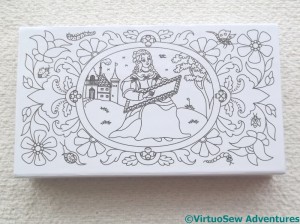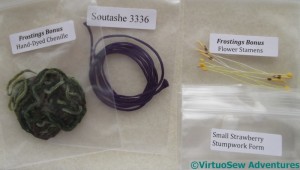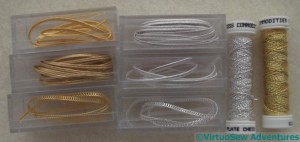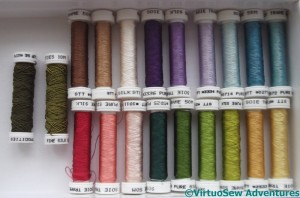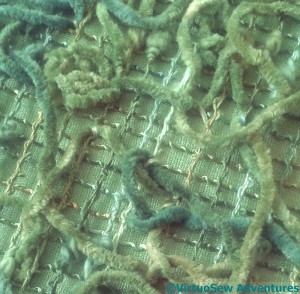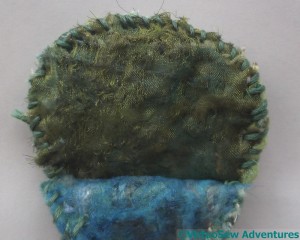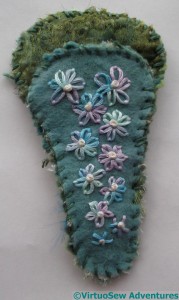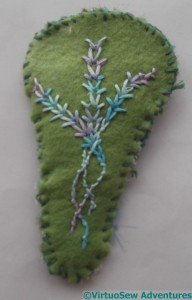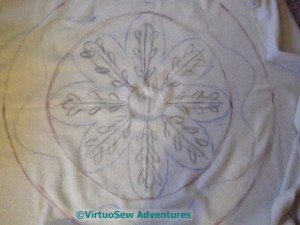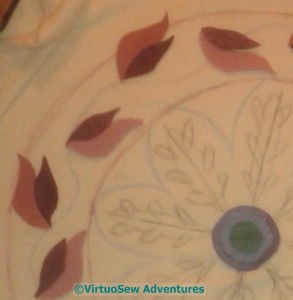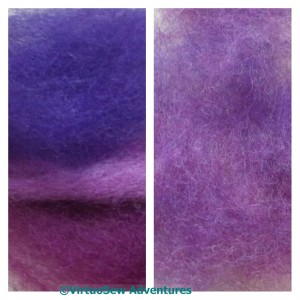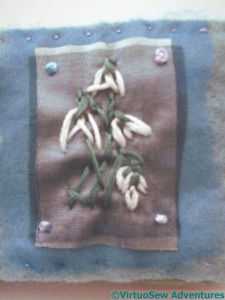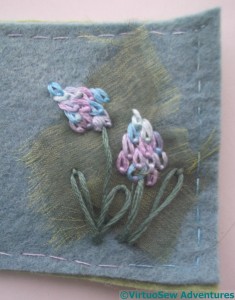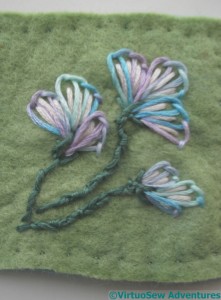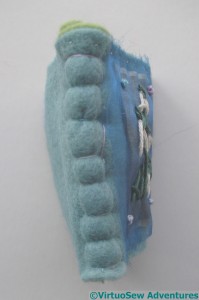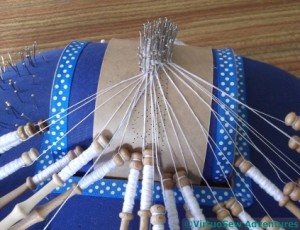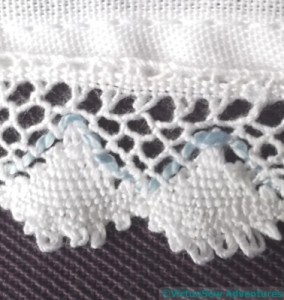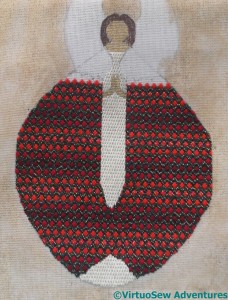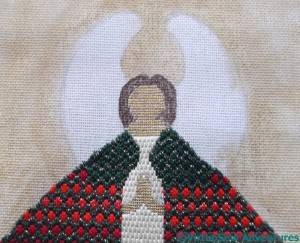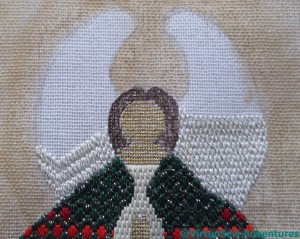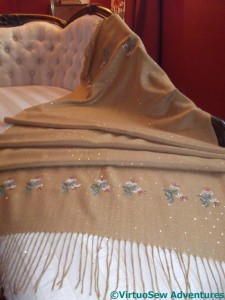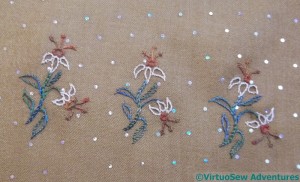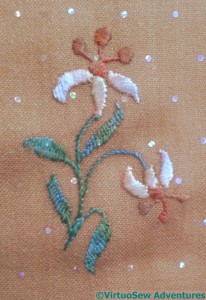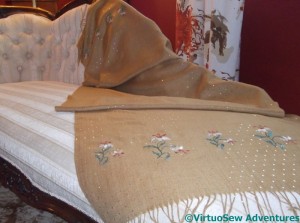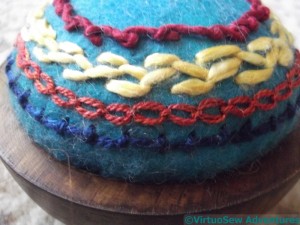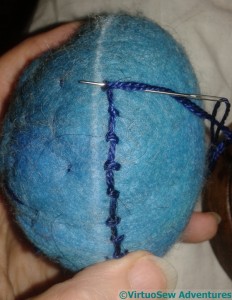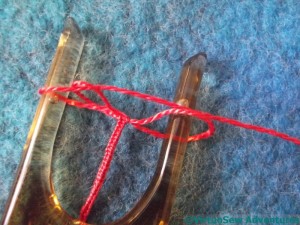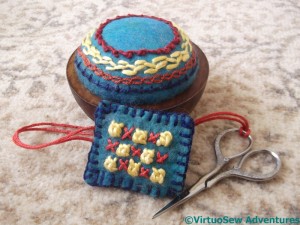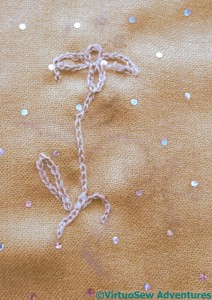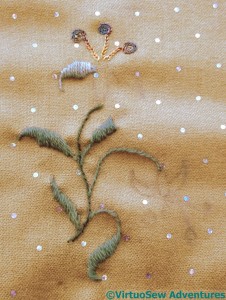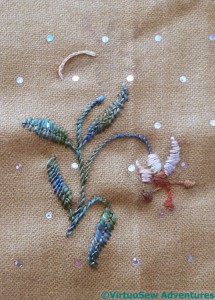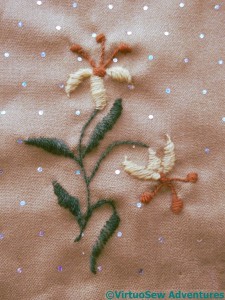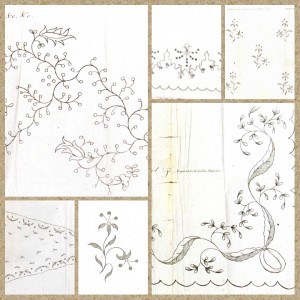Category: General Embroidery
Second Frostings Box
Many bounces and squeaks of excitement…
After a trip to the post box to pay the customs charge (I’ve no idea whether the rules have changed, or whether they’ve just got a bit zealous – Tricia has always been scrupulous in declaring contents on the package), I have received my second Frostings Box from Thistle Threads.
And yes, it’s in the same glazed card box with a magnetic clasp. Sturdy, and lovely to look at!
At risk of making everyone drool all over their keyboards, here’s the low-down – together with some of my ideas…
There is some hand-dyed chenille (that’s destined for Placidus, if I don’t find a use for it earlier). I haven’t an immediate use for the soutache or the strawberries, but the Flower Stamens may come in handy for the Violets…
I’m not quite so sure about the metal threads.
I’ve not got them out of their boxes to work out how to use them, but they might make embellishment on the jerkin for Placidus, or on Jason and Medea’s clothing for The Golden Fleece. Or even form parts of Egyptian jewellery for the Dreams of Amarna.
Finally there are two silk gimps (all on their own to the left of the picture) and a lovely selection of fine filament silk Trame. These are in some of the colours used in the Soie Ovale, but much finer, and as Tricia describes in a recent post, the whole idea here is to allow us to twist our own threads, blending colours and thicknesses to achieve the effect we want.
Music to my ears!
Inspired By Spring Flowers – 2
Once I’d finished the little needlebook, using the little pack from Rowandean, I thought I might have a bit more of a play, and make a scissors case and a pincushion.
So I fished out a piece of dyed silk left over from a book box my mother made for her fine binding of The Wind In The Willows, and a whole hank of fantastical, textured threads, and spent an afternoon tacking them in place and then playing with my embellisher, in order to create a mossy, textural piece of fabric to line the scissor case and back the pincushion.
Bear with me, I know the textures would snag the scissor blades! I used some of the pieces of gauze from the kit – also run gently through the embellisher – to smooth down the lining. The texture is still there, but it has been muted and slightly smoothed over. And now the scissors will be beautifully padded and protected!
The edges are simply whipstitched – a considerable effort, through two layers of felt and two layers of the embellished fabric, but I’m glad to say I didn’t break any needles doing it!
For the front and back, again I used simple stitchery, in undivided stranded cotton. A vaguely wisteria-like (not really Spring any more…!) fall of lazy daisy flowers with French Knot centres enliven the front.
And three wheatear stitch stems (seedheads left over from winter, perhaps…?) decorate the back.
The variegated thread makes all the colour changes happen by magic, and since my other main project at the moment is the 40-count tent stitch of Eve In the Garden Of Eden, six strands of stranded cotton is a blessed relief..!
Lady’s Magazine Stitch-Off – A Modern Adventure
I have a matchless talent for complicating my life. In my defence, I can say that this will be practice for future projects, but oh, my…
I have always had in mind to try a full-on-modern, Jane-would-never-have-done-this, take on one of the Stitch-Off designs. This is going to be that project.
I’ve been intending to do something with this blanket for quite some time, and I’ve also been intending to have a serious play (as it were) with my embellisher. Not the least of the challenges will be in managing a full size, pure wool blanket – nearly six foot square, and heavy.
I’ve sketched out the central medallion from the design for the child’s cap by eye. From now on, it’s a venture into the unknown…
I began by cutting leaf shapes in two colours out of two different types of felt, and alternating them around the circle. My wavy stem line wasn’t quite even, so I’ve tried to even up the spacing by eye, and attached the leaves roughly.
I’m expecting to build up this pattern in layers, and fine-tune the felting as I go, so the first stage here is just to make sure nothing moves too much..
Originally needle-felting was an industrial process for making a non-woven fabric. It dates back to about the 1860s, and these days is used for things like geotextiles and insulation. A quick rummage online told me that among the applications are tiles on the Space Shuttle and tennis court surfaces. The application to craft and art is much more recent, but it uses exactly the same needles – just not as many of them!
However, because of this background, an embellisher is a great way to use wool fibre as well as fabric in a project, and that in turn means an opportunity to play with colours. One of the strongest memories I have of my childhood introduction to the textile industry is visiting a woollen mill in Totnes in Devon, which made upholstery fabrics. The manufacturing process began with bales of alarmingly bright colours of wook fibre being thrown into a carding machine, and ended with wonderfully subtle, lively colours of fabric coming off the looms. I’m going to see what I can do to emulate this intimate blending of colour using my little hand cards.
Inspired by Spring flowers..
You may recall that last year – or was it the year before? – I joined in a “Make & Take” at the Rowandean stand in Harrogate. Last time, I bought a little kit and one of Katrina’s pages of ideas and brought them home to play with.
Of course, as we all know, the Bringing Home is the easy part… !
The colours are soft and fresh, springlike, so I thought I would start by playing with forms vaguely inspired by spring flowers. The ultimate inspiration here was from snowdrops, made by stitching a fly stitch and a twisted fly stitch on top of one another. It has almost worked, certainly close enough for my purposes. Maybe an embroidering botanist would like to play a bit more.
The flowers are stitched on a piece of gauze which is layered over a piece of silk, which in turn lies over apiece of felt. The french knots in the corners held everything together while I tackled the flowers.
The next fragment was vaguely inspired by grape hyacinths, which are among my favourite spring flowers. Overlapping detached chain stitches worked well, and layering gauze over the felt helped to bring the flowers out from the background.
I may choose to fray the gauze further, but I was struggling with light at this point and decided to see what I thought under different atmospheric conditions!
I did mention that I’m no botanist! The ultimate inspiration here were the stripy crocus I see a lot near where I live. They are getting a little old and blowsy, not the trim, upright bolts of colour that first appeared, but nevertheless the ones I’ve stitched look more like some strange new flora, unknown to either science or art!
I rather enjoyed them, all the same…
I’ve turned the resulting pile of felt into a needlebook, rather more illustrated that is usual, and with a dramatic stitched spine. This was a distinct piece of experimentation – I could have done with a milliner’s needle, but not having one I improvised with a beading needle, which was very flimsy and flexible, but did the job in the end.
Now I’ve put it under a heap of books to flatten it gradually without the squashing effect of an iron. And I still have some felt, some thread, and some gauze left over for further experimentation!
Lace for Topsy..
Another report from my mother on the project to clothe Topsy..
Topsy’s dress is going to give me a reason for stitching and lacemaking. I have done some torchon lace but I want to learn a new kind of lace – Bucks Point. Lace making looks far more complicated that it is, at least when using simple patterns. There’s lots of guidance, since the design is pricked out (literally) on stiff card, often with little symbol to help you remember which stitch you are doing. The bobbins’ weight provides the tension, hence the decorative beads, and in all the patterns I have used so far, I was working with only four bobbins at any one time, even though there may be twenty, thirty, forty bobbins in the design.
I have chosen the very simplest pattern, just the new “ground” and a “cloth” fan. For none-lacemakers, the ground creates that part of the design where you are just space filling, in this case it joins the fan to the footside (the straight edge which will be used to mount the lace on cloth). The cloth stitch is made by a weaver pair of bobbins going under and over the other threads just as if you are weaving cloth. The complication lies in remembering the sequence of stitches – it took an hour and a half to work out the sequence for one fan and attached ground. Since the design is a simple repeat, the next one took three quarters of an hour with much referring back to instructions. Six fans on, it takes half an hour with just occasional glances and I am looking forward to cutting down the time as I continue. There is a long way to go as this piece is to edge Topsy’s petticoat. I have more ambitious plans for the dress itself.
It took four months, but I completed the first length of lace and attached it to Topsy’s petticoat. And I am pleased with the result. It’s neat, decorative, not flamboyant – just what I wanted. The first two or three sections are a bit wobbly but thereafter the pattern becomes more crisp. The blue gimp will echo the embroidery on the dress.
I had some difficulty in remembering not to cover the pin in this style of lace making, since doing just that was an essential part of all the Torchon lace I have made. But once I’d mastered that, the ground became easy to do, and, of course, the fan was worked exactly as I had done in previous lace making. Heartened by this, I felt I was ready for something more complicated.
Stitching the Christmas Angel
Rather than being stitched in time for Christmas, I found myself stitching the Christmas Angel over Christmas. About halfway through the stitching, I also coloured in the hair with brown pen. It helps keep the head distinct from the background and the wings, and somehow pulled the whole thing into focus.
My invented bargello pattern of various pearl cottons, including some with a metallic twist in them, has turned out fairly well, if redder than I expected.
As a result, I chose to stitch the shoulder cape in greens. There are two variants here – green with a gold thread and green with a bright green thread. I’ve been using the green and gold as the striped “framework” for the Cape, so I simply used the green and green for the spots. The shoulder cape will be outlined to allow for a bit more shaping, using couched gold thread, but that’s one of the last elements of the design.
The next challenge was to decide how to work the wings. I started off wanting to create some sort of strong patterning, just with the stitches, but in the end I realised that, as the background is going to be strongly patterned, and the cape is so striking, the eye will need somewhere to rest.
So, plain brick stitch it is, although in another of those glitter-twisted pearl cottons, which are quite ridiculously tender and tricksy to stitch with, at least on this canvas. Even Gilt Sylke Twist and Gold Wyre seem robust by comparison!
The Great Lady’s Magazine Stitch-Off – 3
If I were writing a report card for myself, I would write: Rachel has made a good attempt, but continued application is required to produce excellence.
Finally, after much muttering, wrangling, and stitching, I have finished the pashmina I decided to embellish as a part of the Great Lady’s Magazine Stitch-Off. I’ve washed it (carefully, by hand) and pressed it (carefully, on a cool wool setting) and photographed it draped over my parents’ settee, which isn’t the right period, but does make a lovely backdrop..
Time alone will tell whether it is a practical piece that I enjoy wearing and don’t spend all my time repairing, but for now I am pleased. Although I must admit, rather more of the little paillettes flew off in the course of the stitching than I was expecting. It will only be dotty in patches!
One end has a row of motifs, all the same size, and worked purely in outline. Primarily I have used stem stitch, although split stitch and chain stitch both make an appearance, too.
The small motifs were fairly quick to stitch, and didn’t require much self-discipline because I could see the progress I was making. I’m not good at repeated motifs – I lose interest quickly – so this was very good news.
At the other end, the motifs are larger – in two different sizes in fact, two larger ones interspersed with three slightly smaller.
The larger motifs used a wider combination of stitches. Stem stitch for the stems – naturally! Satin stitch for the petals, worked over a split stitch outline, and using three strands of the stranded silk thread instead of two. It might have been better to use four, in terms of the coverage, but that would entail larger holes in the fabric, and I wasn’t willing to do that.
The leaves are worked in Romanian Couching, using the couching stitch to create a vein up the centre. Since the green thread is an unspun, indeed untwisted floss silk, it spread nicely. It has also got a mind of its own and unstitches itself unless finished off with great thoroughness.
One of the reasons the researchers wanted to extend the stitch-off project was to see whether they would gain any insights from it into the lives and work of the readers of The Lady’s Magazine. One thing I’m sure they will be reminded of anew is that the designs may be the same, but the treatments so different as to render them almost unrelated in appearance.
As I said in my earlier post, I have a renewed respect for any lady who embroidered her own silks and muslins, but I should also highlight something I believe we are inclined to forget. I’m sure the general standard of embroidery was good – it was an expected accomplishment, after all, – but I don’t believe it was all as breathtakingly exquisite as what we see in some surviving pieces.
Textiles were extremely valuable until quite recently. They were reused, altered, left as bequests. The pieces that remain are either fortunate accidents of history (a forgotten trunk in an attic, say) or they were so remarkable as to be treasured. Embroidery worked at home for a day dress or other garment would have been worked quickly so that it could be worn, and in due course the dress cut down into something else, and finally, no doubt, sent for rags. The little aprons which protected expensive wool and silk dresses had to survive the washing of the day – pounding in a tub of boiling water – and again, when they could no longer be made respectable, became cleaning rags.
I wrote an entire post about transferring designs, but again, drawing was an expected and widespread skill. Many of the readers may have simply copied the design freehand onto their fabric, unconcerned about pinpoint accuracy, aiming only to provide an approximate guide for their needle. These are skills no longer as widespread, and we trust ourselves less than they would have done.
This isn’t evidence of one of my finest hours, but it is a perfectly competent piece of work, perhaps in the traditions I have just described, of work done quickly for a particular occasion or event. I am going to send it to Chawton House as a contribution to their exhibition celebrating the 200th anniversary of the publication of Jane Austen’s “Emma”.
Worked on a whim
Just before Christmas I was struggling with the “Dreams of Amarna” designs, but I still had itchy fingers from longing to stitch, and sore eyes from staring at “Eve In The Garden of Eden“, so I wanted something a bit less precise..
My Dad’s shaving cream comes in a rather nice wooden pot. There are refills, but sometimes the shop doesn’t have them, and consequently – since they’re much too nice to throw away – my parents have ended up with something of a stockpile. I’ve taken one of them off their hands, and turned it into a pincushion.
At the moment the lid is being used as a coaster, but I am open to suggestions for it!
The threads are silks, bought at the Knitting and Stitching Show, worked on felt acquired at the same time. I created the shape of the pincushion itself with shaping stitches, stitching around and around the padding and the felt top layer, rather as doll and puppet makers do, and once I’d settled it into the bowl, I drew a chalk line around the waist, took the pincushion out, and started stitching.
Coral Stitch, Cable Chain (do I ever do anything that Cable Chain doesn’t sneak into somehow?), Semi-Closed Feather Stitch, and Scroll Stitch, all stitched into the felt, catching as little of the stuffing as I could.
Then I decided to do make a scissors-keeper for my lovely Ernest Wright and Son Ltd scissors, so I started by using one of the threads, and my lucet, to make a cord for it. I’d forgotten some of the knack of lucetting, but it came back gradually, and it’s ever so satisfying!
The stitches on the scissors keeper are Sorbello Stitches (another favourite of mine) and Tied Cross Stitches, and the the pieces of felt are stitched together with ordinary blanket stitch. In silk!
Don’t they look good…!
Great Lady’s Magazine Stitch-Off – 2
Sigh.
The pashmina, when it arrived, was a lovely caramel colour, with rather unanticipated silver spots on it, and it was a good deal flimsier than I was expecting. The others I have are all in fairly sturdy twill weaves. In truth, I’m not sure that would be easier, and if I ever finish this one, I may choose to find out..
Regular and long term readers of my blog will be aware that I have a thing about scale – scale of thread, scale of stitch, scale of weave. I’ve even discovered – much to my surprise – that the dreaded Plaited Braid Stitch isn’t always easier when it’s stitched wider and longer. So it will be no surprise that I spent a bit of time playing with various different threads to see what I thought of them, before settling on a final choice.
Scale isn’t the only concern, either. The right texture and sheen matter as well.
In the end I have settled on silks. The Medici yarn might have worked if I had had more of it, but I don’t think it is even made any more. The Appletons crewel wool was too heavy, and the Gumnut yarns (although I love them) somehow didn’t settle in comfortably.
Now I have to unpick my experiments and get started. I already have a newfound respect for any lady of the period who embroidered her muslin dresses, or her silk gauzes. There’s a story that Jane Austen embroidered a muslin dress with satin stitch spots, and the mere idea gives me cold shivers!
Although I doubt they had to contend with stuck-on paillettes!
The Great Lady’s Magazine Stitch Off
Rummaging around on Twitter, I found a most intriguing idea. A research team at the University of Kent, headed by Dr Jennie Batchelor (@jenniebatchelor on Twitter), is investigating the content and development of an eighteenth century periodical, The Lady’s Magazine. The magazine was sold with pull-out song sheets – and pull-out designs for embroidery. Generally speaking, they don’t survive, having been pulled out and used as they were intended to be.
But recently, a bound volume of a half-year (1796) came to light, with some patterns included. A little more discussion, the idea arose of scanning those designs for modern stitchers to play with, and The Great Lady’s Magazine Stitch-Off was born. For more on that, visit the project’s blog post on the subject.
I couldn’t resist the idea. I’ve downloaded the first five designs, and started to stare at them thoughtfully. The project suggests that stitchers might like to work modern versions as well as in some cases working versions which are as historically accurate as possible, so there is going to be quite a variety to look at.
I’ve decided that I’m going to work the designs on a pashmina shawl, and while I am waiting for it to arrive, I’m contemplating what I might choose to do, from highly modern needle-felted versions, to more or less classical embroidery.
I wanted to share it with you before I started stitching, because the vagaries of the post may substantially delay my first stitch, and a few of you may want to join in. Do let the project know if you do, they’re really enjoying what they’ve been seeing!
Update: They have recently posted their first round-up of Stitch Off contributions and planned contributions.

